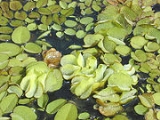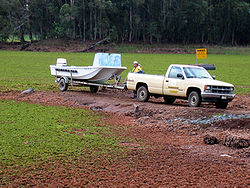
Giant salvinia
Encyclopedia

Lake Kariba
Lake Kariba is the world's largest artificial lake and reservoir. It lies 1300 kilometers upstream from the Indian Ocean, along the border between Zambia and Zimbabwe...
of the same name, is an aquatic fern, native to south-eastern Brazil
Brazil
Brazil , officially the Federative Republic of Brazil , is the largest country in South America. It is the world's fifth largest country, both by geographical area and by population with over 192 million people...
. It is a free floating plant that does not attach to the soil, but instead remains buoyant on the surface of a body of water. The fronds are 0.5–4 cm long and broad, with a bristly surface caused by the hair-like strands that join at the end to form eggbeater shapes. They are used to provide a waterproof covering. These fronds are produced in pairs also with a third modified root-like frond that hangs in the water.
Favoured environmental conditions
S. molesta prefers to grow in slow moving waters such as those found in lakes, ponds, billabongs (oxbows), streams, ditches, marshes and rivers. It prefers nutrient rich waters such as those found in eutrophic water or those polluted by waste water. It does not usually grow in brackish or salty waters but has been reported in streams with a tidal flow in southeast Texas. It copes well with dewatering and while it prefers to grow in moderate temperatures it will tolerate temperatures that are low or very high. the United States Geological Service believes that it could grow in Zones 7a, 8, 9, and 10 of the USDA Plant Hardiness Map.Methods of introduction
The plant originated in southeast Brazil and was exported as part of the pet industry to be used in aquariums and garden ponds. From there it escaped or was deliberately released into the wild. It is possible that it may also have been brought in with fresh, iced fish. Once in a waterway it can be spread by infested boats which not only spread it to new areas but also break the plant up which allows it to propagate. It also is spread by waterflow.Reproduction
It reproduces by asexual reproduction only, but it is capable of growing extremely quickly, starting from small fragments and doubling in dry weight every 2.2-2.5 days. It grows from fragments that have broken off or dormant buds that have been detached from the main plant. Each node has five buds so potential for great & rapid spread is high. It also produces spores but they are genetically defective and do not produce viable offspring.Effect
The result of the rapid growth rate of Salvinia molesta has resulted in its classification as an invasive weed in some parts of the world such as Australia, New Zealand and parts of America. Surfaces of pondPond
A pond is a body of standing water, either natural or man-made, that is usually smaller than a lake. A wide variety of man-made bodies of water are classified as ponds, including water gardens, water features and koi ponds; all designed for aesthetic ornamentation as landscape or architectural...
s, reservoirs, and lake
Lake
A lake is a body of relatively still fresh or salt water of considerable size, localized in a basin, that is surrounded by land. Lakes are inland and not part of the ocean and therefore are distinct from lagoons, and are larger and deeper than ponds. Lakes can be contrasted with rivers or streams,...
s are covered by a floating mat 10–20 cm (in some rare cases up to 60 cm) thick. The plant's growth clogs waterways and blocks sunlight
Sunlight
Sunlight, in the broad sense, is the total frequency spectrum of electromagnetic radiation given off by the Sun. On Earth, sunlight is filtered through the Earth's atmosphere, and solar radiation is obvious as daylight when the Sun is above the horizon.When the direct solar radiation is not blocked...
needed by other aquatic plants and especially algae
Algae
Algae are a large and diverse group of simple, typically autotrophic organisms, ranging from unicellular to multicellular forms, such as the giant kelps that grow to 65 meters in length. They are photosynthetic like plants, and "simple" because their tissues are not organized into the many...
to carry out photosynthesis thereby oxygenating the water. As it dies and decays, decomposers use up the oxygen in the water. It also prevents the natural exchange of gases between the air & the body of water the plant has invaded causing the waterway to stagnate. This can kill any plants, insects or fish trapped underneath its growth. Its ability to grow and cover a vast area makes it a threat to biodiversity. Large infestations covering a wide area may also pose a problem to migratory birds as they may not be able to recognise an infested waterway when flying over head and so may not stop at it. S. molesta also provides ideal conditions for the breeding of mosquitoes that carry disease. The growth habit of Salvinia also is problematic to human activities including flood mitigation, conservation of endangered species & threatened environments, boating and irrigation.
Notwithstanding its invasive species status, researchers at Stephen F. Austin State University
Stephen F. Austin State University
Stephen F. Austin State University is a public university located in Nacogdoches, Texas, United States. Founded as a teachers' college in 1923, the university was named after one of Texas' founding fathers, Stephen F. Austin. Its campus resides on part of the homestead of another Texas founding...
in Nacogdoches, Texas
Nacogdoches, Texas
Nacogdoches is a city in Nacogdoches County, Texas, in the United States. The 2010 census recorded the city's population to be 32,996. It is the county seat of Nacogdoches County and is situated in East Texas. Nacogdoches is a sister city of Natchitoches, Louisiana.Nacogdoches is the home of...
discovered that extracts of giant salvinia have shown promising signs of inhibiting growth of human cancer cells without destroying nearby healthy ones.
Biological control
A tiny weevilWeevil
A weevil is any beetle from the Curculionoidea superfamily. They are usually small, less than , and herbivorous. There are over 60,000 species in several families, mostly in the family Curculionidae...
, Cyrtobagous salviniae
Cyrtobagous salviniae
Cyrtobagous salviniae is a species of weevil known as the salvinia weevil. It is used as an agent of biological pest control against the noxious aquatic plant giant salvinia ....
, found in the native habitat of S. molesta, is currently being studied as a biocontrol
Biological pest control
Biological control of pests in agriculture is a method of controlling pests that relies on predation, parasitism, herbivory, or other natural mechanisms...
. C. salvinae was first used as a biological control in Australia at Lake Moondarra
Lake Moondarra
Lake Moondarra is an artificial lake on the Leichhardt River, 16 km downstream from the town of Mount Isa. It provides water supply to the town and the adjacent Mount Isa Mines mining lease....
, a recreational lake in Mount Isa, Queensland in 1980. By mid 1981 the weevil had reduced the weed to a few small patches. It ate the leaves of the weed but preferred the buds. Its larvae ate the roots, rhizomes and the buds. As the plant died it turned brown and sank to the bottom of the waterway and decomposed. This weevil was used with success in other parts of the world (13 tropical countries) such as the Sepik River in Papua New Guinea; Sri Lanka; Wappa Dam in Queensland and lagoons (e.g. Kakadu National Park
Kakadu National Park
Kakadu National Park is in the Northern Territory of Australia, 171 km southeast of Darwin.Kakadu National Park is located within the Alligator Rivers Region of the Northern Territory of Australia. It covers an area of , extending nearly 200 kilometres from north to south and over 100 kilometres...
) in the Northern Territory, Australia. In Australia the moth, Samea multiplicalis
Samea multiplicalis
The Salvinia Stem-borer Moth is a species of moth of the Crambidae family. It is found from the south-eastern United States south to Argentina. It is an introduced species in Australia, where it is found in Queensland and New South Wales.The wingspan is about 20 mm...
was also released in the hopes that it would reduce the size of the weed population. While this moth did become established in Australia and spread it was not effective as a biological control. A third species, the grasshopper Pauliana acuminata, was considered but not released.
Mechanical control
Plants are removed by machine or harvesting equipment and by hand which is only suitable for small infestations. Harvesting equipment also can encounter difficulties as it cannot remove all of the infestation, it cannot access shallow areas and equipment can be inhibited by large masses of the plant. Once removed the plant must be dried, burnt or disposed of in a manner that ensures it will not reenter the waterway.Chemical control
Chemical control on S. molesta is difficult as it does have some resistance to herbicideHerbicide
Herbicides, also commonly known as weedkillers, are pesticides used to kill unwanted plants. Selective herbicides kill specific targets while leaving the desired crop relatively unharmed. Some of these act by interfering with the growth of the weed and are often synthetic "imitations" of plant...
s. The chemical fluridon has been successfully used but it requires prolonged contact and is not effective if it is suddenly diluted by rainwater or any other influx of water. Other chemicals such as hexazinone and diquat
Diquat
Diquat is a contact herbicide that produces desiccation and defoliation most often available as the dibromide, diquat dibromide. Brand names for this formulation include Aquacide, Dextrone, Preeglone, Deiquat, Detrone, Reglone, Reglon, Reglox, Ortho-Diquat and Weedtrine-D.Diquat is a non-selective...
and double chelated copper are used together to kill S. molesta.
External links
- Salvinia molesta information from the Hawaiian Ecosystems at Risk project (HEAR)
- US Geological Survey: Giant Salvinia
- Wildland Invasive Species Team - Weed alert
- Identification and Management of Giant Salvinia (Salvinia molesta)
- TexasTexasTexas is the second largest U.S. state by both area and population, and the largest state by area in the contiguous United States.The name, based on the Caddo word "Tejas" meaning "friends" or "allies", was applied by the Spanish to the Caddo themselves and to the region of their settlement in...
campaign to prevent spread: Hello Giant Salvinia, Goodbye Texas Lakes - Species Profile- Giant Salvinia (Salvinia molesta), National Invasive Species Information Center, United States National Agricultural LibraryUnited States National Agricultural LibraryThe United States National Agricultural Library is one of the world's largest agricultural research libraries, and serves as a National Library of the United States and as the library of the United States Department of Agriculture...
. Lists general information and resources for Giant Salvinia.

